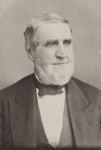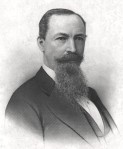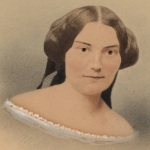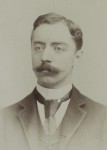(click on images to view larger versions)
Packer and Linderman Families
Dr. Garrett Linderman

In 1854, cholera broke out in Mauch Chunk (now Jim Thorpe) Pennsylvania, the center of Asa Packer’s railroad and coal empire. As the disease spread, and people began dying, two of the three area doctors fell deathly ill as well. The remaining doctor, Garrett Brodhead Linderman found himself in the middle of a crisis.

Dr. G. B. Linderman, only 24 years old at the time, was the son of a respected country doctor, John Jordan Linderman, from the Delaware Water Gap area of Pennsylvania. It was only two years since Garrett had finished his medical studies at the University of New York, under Dr. Valentine Mott. He had taken over the practice of his older brother, Dr. Henry Richard Linderman, who had become exhausted by the profession, and took a position as Director’s clerk at the US Mint in Philadelphia.

Dr. H. R. Linderman left Philadelphia to assist his brother in Mauch Chunk. As the situation worsened, the leading men of the town desperately implored James R. Snowden, Director of the Mint to give H. R. Linderman leave of absence to stay until the crisis was abated. This Snowden granted.

The Linderman brothers wore themselves out in constantly attending to the cholera patients. The epidemic finally subsided, and the town was saved. Dr. H. R. Linderman returned to Philadelphia (eventually becoming Director of the Mint in 1867). The ordeal of the epidemic apparently induced Dr. G. B. Linderman to change profession as well. He must have earned the respect and gratitude of Asa Packer, as he soon was engaged in Packer’s circle of business interests, and in1856, he married Asa’s daughter Lucy. He and his young family remained in Mauch Chunk for the next 14 years, living much of that time there in an apartment on Broadway Street.
Linderman Builds a Mansion
Dr. G. B. Linderman was active in Coal, and banking. He became involved in Bethlehem Iron (precursor to Bethlehem Steel), and was soon the second largest shareholder, and managing director. He built a 27 room mansion, designed by architect Bruce Price, on Delaware Ave in the Fountain Hill area of South Bethlehem. Once completed, he and his family moved there in late 1870. Besides the mansion house, the property included a carriage house, stables, housing for the gardener, and extensive greenhouses. Dr. Linderman even had a 9-hole golf course put in on a 20 acre lot he owned about a half mile from the mansion, known locally as the “Linderman Golf Grounds”. The grounds of the mansion house were fastidiously maintained, overseen by Linderman’s long time gardener, Patrick Smith. Tender landscaping were moved into greenhouses by the mansion where they spent the winter before replanting in the spring.






The Lindermans had a daughter and four sons. Two of the sons, Asa Packer Linderman and Harry Packer Linderman died before reaching one year of age. Their surviving children were Sallie, Robert, and Garrett Jr. Their last child, Harry, was born at the new mansion in 1871, and died 9 days later. In 1873, Dr. Linderman’s wife, Lucy Packer Linderman died at the mansion at the young age of 41. Death visited the mansion again in 1879 when the mansion hosted the funeral for Dr. Linderman’s brother Dr. Henry Richard Linderman, Director of the U. S. Mint, who had died in Washington DC.
In 1880, the 50 year old Dr. Linderman remarried to Frances Armenia Evans, the 20 year old daughter of a Brooklyn, New York businessman. Two daughters, Lillian and Ida were soon born to them.


In 1884, Garrett had a large house built next door for his eldest son, Robert Packer Linderman on the occasion of Robert’s marriage to Ruth May Sayre, daughter of Asa Packer’s indispensable business associate Robert Heysham Sayre.
Frances was pregnant with their third daughter Helen when Dr. Garrett B. Linderman died at the mansion in 1885. Dr. Linderman’s widow Frances moved to Brooklyn, and remarried in 1888 to James McKinley Graeff.
Garrett Linderman Jr.


After Dr. Linderman’s death, his younger son, Garrett Brodhead Linderman Jr., purchased the Linderman mansion though he was in his early 20’s, single, and still attending nearby Lehigh University. Garrett Jr., hosted a large graduation party at the mansion for his class in 1887.

In 1889, Garrett married his 2nd cousin, Jennie Seymour Brodhead. Five boys were born to them while they lived in the mansion, Garrett, Robert, Beverly, Stuart, and Sydney. In 1892, Jennie’s father Abram Coolbaugh Brodhead died at the mansion.
On New Year’s Day, 1901, there was much excitement when the gardener’s boy, Charles Kerschner reported having been kidnapped the night before after being mistaken for one of Garrett’s sons. He said he was released after finally convincing the kidnappers of their mistake. This threw the family in a panic. The famous Cudahy kidnapping for ransom had occurred just a few weeks prior, and was still in people’s mind. After the initial scare, the gardener’s boy confessed he had in fact traveled to Allentown for some New Year’s Eve fun and concocted the story to avoid getting in trouble.

1903 was a difficult year for the Lindermans. In late January, Garrett’s brother, Robert Packer Linderman, who lived across the street, died of blood poisoning from a minor scratch he got while playing with his children during Christmas. Robert was only 39, and had been the first president of Bethlehem Steel. He and Joseph Wharton (founder of the Wharton School of Business), the two largest shareholders had arranged the sale of Bethlehem Steel to Charles Schwab in 1901.
In early February, 1903, the buildings behind the Garrett Linderman mansion housing the fine stables, carriage house, and coachman quarters were destroyed, and the gardener’s quarters were damaged by fire. In April, Garrett’s beloved spinster aunt, Sarah Linderman died at the mansion. It was said that her death was hastened by the shock of her nephew Robert’s unexpected death in January.







Beginning in 1901, Garret began getting involved in speculative gold mining enterprises in Arizona and Montana. His financial involvement became increasingly significant through 1905. In 1906, these mining investments began failing, and the extent of Garrett’s indebtedness started coming to light. In 1907, his finances came crashing down. His fate was sealed through a combination of his own excessive leverage on wildly speculative bets, being duped by an infamous con man of the time, and his unfortunate association with F. Augustus Heinze whose attempt to corner the market in United Copper Company triggered the Panic of 1907. In 1908, Garrett was involuntarily forced into bankruptcy.
Charles M. Schwab
In May, 1909, Garrett’s property was seized so it could be liquidated for his creditors. The Garrett B. Linderman mansion was sold in June by the sheriff at public auction, and was purchased by General Doster for $2,000. The following month, the mansion was bought by Charles Schwab, who had purchased Bethlehem Steel in 1901. Schwab had been renting the Robert P. Linderman house from Robert’s widow. During the rest of 1909, Schwab engaged local architect A.W. Leh to undertake extensive remodeling of the mansion. The first round of modifications added an imposing portico for the front entry held by large chains, the front porch was converted to a conservatory, the library improved, and three bathrooms, a music room, and a billiard room were added. The property fencing, entry gate and landscaping were also replaced to Schwab’s tastes. Schwab moved into the mansion in early 1910. The second set of modifications began around 1914, and completely changed the exterior look of the house. The brick exterior was replaced with light colored granite and stucco, a red tile roof was installed, and the design of the tower was modified. During Schwab’s ownership, he is said to have spent $120,000 to $500,000 on modifications, depending on which source you believe.



Schwab is said to have called his 27 room mansion “the little house”. The first floor contained a dining room, large parlor and billiard room, and conservatory. The second floor had four large bedrooms, three baths, and sitting room. The third floor housed the servants quarters. A small stairway led to the tower. In the basement was a tile lined vegetable cellar and arched wine vault.
Schwab lived in the mansion off and on from 1910 to 1914. After him, the mansion was occupied by Eugene Grace, president of Bethlehem Steel while Grace’s home was being remodeled. The next occupants were Mrs. Jeanette “Nettie” Mock, the sister of Schwab’s wife, who, with her husband, used it as a winter home until 1932. Also living in the house around 1930 was Schwab’s aunt, Delia Schwab. After 1932, the house sat vacant for many years. In 1939, shortly before Schwab’s death, the contents of the mansion, including Schwab’s many paintings, antiques, statues, and furnishings were sold off. When Schwab died in the fall of 1939, he was in debt and living in a small New York apartment, the result of lavish spending, the Stock Market Crash of 1929, and the Depression that followed.
End of the Gilded Age
In 1942, several failed attempts to auction the mansion were made, but there were few offers, and none met the minimum of $8,000. Finally the house and grounds were sold to Andrew Augustine, a contractor, for $10,000. Realizing that the property was a tax liability for him, he sold it in 1944 for $8,500. The new owner, Joseph Illick, converted the building into eleven apartments, as he did with two nearby mansions owned by the Wilbur family, relatives of the Lindermans. In 1945, he also converted the former mansion stables/caretaker building into six additional apartments.
In December 1965, the mansion was nearly lost. A fire started in the basement, traveled up a dumbwaiter shaft, and heavily damaged the third floor, attic, and roof. Several firefighters were injured while fighting the blaze, and were sent to the hospital. Fortunately, all the apartment residents were successfully evacuated, although they were left homeless.
The fire damage was repaired, and the mansion has survived to this day as apartments, still owned by the Illick family as recently as 2018. The current address of the building is 557 W. 3rd St., Bethlehem, PA.




Owners and Residents
Owners
- 1870-1885 Dr. Garrett B. Linderman
- 1885-1909 Garrett B. Linderman Jr.
- 1909 General Doster
- 1909-1939 Charles M. Schwab
- 1942-1944 Andrew Augustine
- 1944- Joseph Illick
Residents
- Lucy (Packer) Linderman (wife of Dr. G. B. Linderman)
- Frances (Evans) Linderman (wife of Dr. G. B. Linderman)
- Sarah Marie Linderman (sister of Dr. G. B. Linderman)
- Sallie Packer Linderman (daughter of Dr. G. B. Linderman)
- Robert Packer Linderman (son of Dr. G. B. Linderman)
- Harry Packer Linderman (son of Dr. G. B. Linderman)
- Lillian Valentine Linderman (daughter of Dr. G. B. Linderman)
- Ida Linderman (daughter of Dr. G. B. Linderman)
- Jennie (Brodhead) Linderman (wife of Garrett B. Linderman Jr.)
- Garrett Brodhead Linderman III (son of G. B. Linderman Jr.)
- Robert Seymour Linderman (son of G. B. Linderman Jr.)
- Beverly Warner Linderman (son of G. B. Linderman Jr.)
- Stuart Henry Linderman (son of G. B. Linderman Jr.)
- Sidney Ely Linderman (son of G. B. Linderman Jr.)
- Jane Seymour Linderman (daughter of G. B. Linderman Jr.)
- Emma Eurana (Dinkey) Schwab (wife of Charles Schwab)
- Carlton S. Wagoner (nephew of Charles Schwab)
- Jeannette E. (Dinkey) Mock (sister of Charles Schwab’s wife)
- John F. Mock (husband of Jeanette Dinkey)
- Delia Schwab (aunt by marriage of Charles Schwab)


Staff (who likely lived in the mansion or residences on the grounds)

- Patrick Smith, Gardener during Dr. G. B. Linderman’s time
- Thomas Love (and family), Gardener during Dr. G. B. Linderman’s time
- Oliver F. Kerschner, Gardener during G. B. Linderman Jr.’s time
- George W. Wright (and family), Coachman during G. B. Linderman Jr.’s time
- Patrick Cunningham (and family), Coachman during Charles Schwab’s time
- Cathrine Muhny, Servant during Dr. G. B. Linderman’s time
- Martha Roun, Servant during Dr. G. B. Linderman’s time
- Kelly Bridget, Servant during Dr. G. B. Linderman’s time
- Nellie Dugan, Servant and Nurse (Nanny) during G. B. Linderman Jr.’s time
- Sarah Milan, Servant during G. B. Linderman Jr.’s time
- Nellie Lyons, Servant during G. B. Linderman Jr.’s time
- Nellie Moran, Servant during G. B. Linderman Jr’s time
- Miller Lintor, Servant during Charles Schwab’s time
- Carl Carlson, Servant during Charles Schwab’s time
- Mary E. Blume, Servant during Charles Schwab’s time
- Margaret C. Ruchte, Servant during Charles Schwab’s time
- Amelia Hottenson, Servant during Charles Schwab’s time
- Gertrude Mahler, Servant during Charles Schwab’s time
- Sarah Higgins, Servant during Charles Schwab’s time
- Elizabeth Sheeler, Servant during Charles Schwab’s time
Thanks to:
Linderman Family
The Moravian Archives, Bethlehem, PA
Linderman Library, Lehigh University, Bethlehem, PA
Ken Raniere
Jim Bullock
Pierce Rafferty, Henry L. Ferguson Museum, Fishers Island

